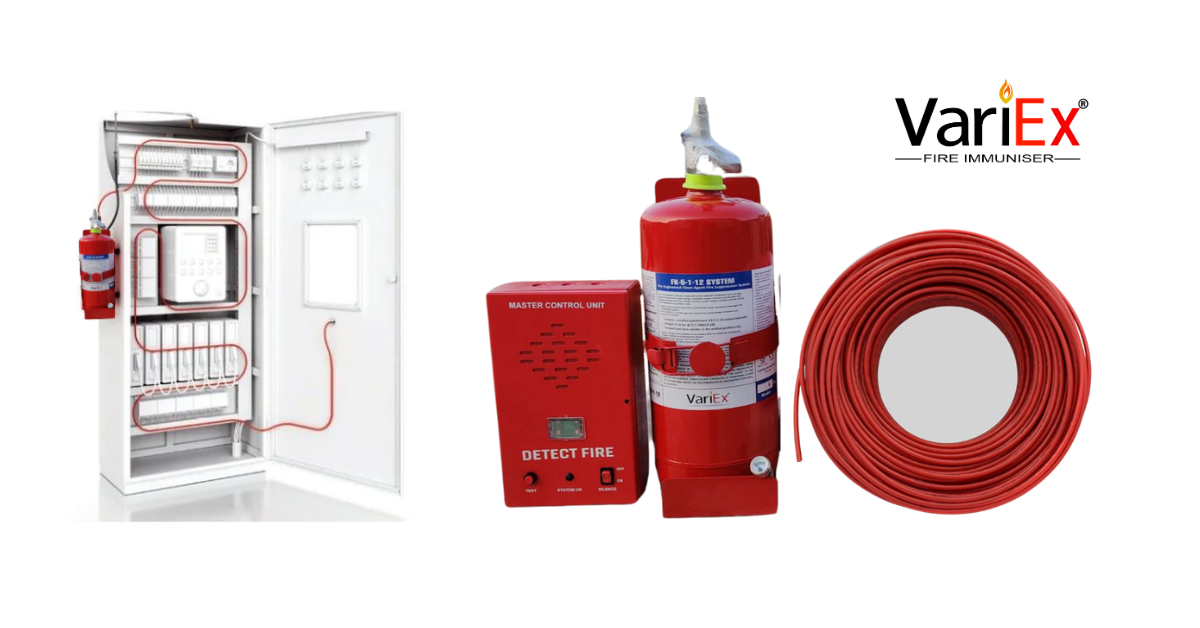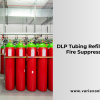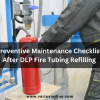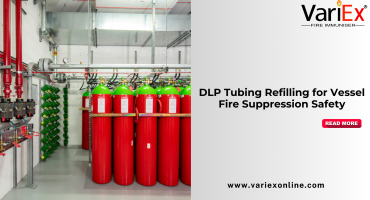![]()
Fire Immuniser
+91-7829629111
Email: info@variex.in
Varistor Technologies Pvt. Ltd.
Block-1, First Floor, Ardente Office One, Hoodi Circle, ITPL Main Road, Bengaluru, Karnataka 560048, IN
Fire Suppression Tubing System
Fire suppression tubing systems represent a cutting-edge approach to fire protection, offering efficient and reliable solutions for a wide range of applications. These systems utilize specialized tubing that reacts to heat, activating to release a fire suppression agent directly at the source of the fire. In this informational content, we'll delve into the workings, benefits, applications, installation considerations, and safety aspects of fire suppression tubing systems.
How Fire Suppression Tubing Systems Work:
- Heat-Activated Tubing: Fire suppression tubing is engineered with a heat-sensitive material that ruptures when exposed to high temperatures.
- Direct Suppression: When a fire ignites nearby, the heat from the flames causes the tubing to rupture, releasing the suppression agent directly onto the fire.
- Localized Protection: Fire suppression tubing systems offer targeted protection, minimizing the need for extensive piping and reducing response times for effective fire suppression.
Benefits of Fire Suppression Tubing Systems:
- Rapid Response: Fire suppression tubing systems provide rapid response to fire incidents, minimizing the spread of flames and reducing property damage.
- Automated Activation: These systems operate autonomously, requiring no human intervention to detect and suppress fires, enhancing reliability and effectiveness.
- Space Efficiency: Fire suppression tubing can be installed in tight or hard-to-reach spaces, offering flexible protection for various applications, including electrical panels, machinery, vehicles, and storage areas.
- Minimal Maintenance: With no moving parts or complex components, fire suppression tubing systems require minimal maintenance, resulting in lower operational costs and increased system reliability.
Applications of Fire Suppression Tubing Systems:
- Electrical Panels: Fire suppression tubing is commonly used to protect electrical panels and control cabinets, providing localized protection for critical equipment and preventing fire spread.
- Vehicle Engine Compartments: In automotive and transportation industries, fire suppression tubing systems are installed in engine compartments to suppress fires quickly and prevent vehicle damage.
- Server Rooms and Data Centers: These systems offer an effective solution for protecting sensitive electronic equipment in server rooms and data centers, minimizing downtime and data loss.
- Industrial Machinery: Fire suppression tubing systems are installed in industrial machinery and equipment to safeguard against fire hazards, ensuring uninterrupted production processes and worker safety.
Installation Considerations:
- Proper Tubing Placement: Fire suppression tubing should be installed in close proximity to potential fire sources, ensuring rapid activation and effective suppression.
- Agent Selection: The selection of suppression agents should consider the type of fire risks present in the application, with options including clean agents, dry chemicals, and foams.
- Integration with Existing Systems: Fire suppression tubing systems can be integrated with existing fire detection and alarm systems for enhanced protection and coordination.
Safety Aspects:
- Occupant Safety: Fire suppression tubing systems enhance occupant safety by swiftly suppressing fires at their source, minimizing the risk of injury or loss of life.
- Environmental Impact: Consideration should be given to the environmental impact of suppression agents used in fire suppression tubing systems, ensuring compliance with regulations and minimizing ecological footprint.
Advanced Features and Considerations for Fire Suppression Tubing Systems:
1. Multi-Zone Protection:
- Advanced fire suppression tubing systems can be configured to provide multi-zone protection, allowing for customized coverage tailored to the specific fire risk profile of each area.
- By dividing the protected space into zones, these systems can optimize suppression agent distribution, ensuring efficient coverage and minimizing agent usage.
2. Self-Contained Systems:
- Some fire suppression tubing systems feature self-contained modules that include both the detection and suppression components within the tubing itself.
- These self-contained systems offer simplified installation and reduced complexity, making them ideal for applications where space or accessibility is limited.
3. Compatibility with Various Suppression Agents:
- Fire suppression tubing systems are compatible with a wide range of suppression agents, including clean agents, dry chemicals, foams, and water mist.
- The choice of suppression agent depends on factors such as the type of fire risk, environmental considerations, and regulatory requirements.
4. Integration with Building Management Systems (BMS):
- Integration with BMS allows fire suppression tubing systems to communicate with other building systems, such as HVAC, access control, and alarm systems.
- This integration enables coordinated responses to fire events, such as activating ventilation systems to remove smoke or initiating evacuation procedures.
5. Early Warning and Remote Monitoring:
- Advanced fire suppression tubing systems may incorporate early warning capabilities, providing alerts of potential fire hazards before they escalate into full-blown fires.
- Remote monitoring capabilities allow facility managers to oversee system status and performance from a centralized location, facilitating swift response to potential fire events.
6. Environmental Considerations:
- When selecting a fire suppression tubing system and suppression agent, it's crucial to consider environmental factors such as toxicity, ozone depletion potential (ODP), and global warming potential (GWP).
- Choosing environmentally friendly suppression agents and materials helps minimize the ecological footprint of fire suppression systems and ensures compliance with regulations.
7. Maintenance and Testing Protocols:
- Regular maintenance and testing are essential to ensure the reliability and effectiveness of fire suppression tubing systems.
- Scheduled inspections, functional tests, and equipment maintenance should be conducted according to manufacturer recommendations and regulatory requirements.
8. Training and Education:
- Personnel responsible for the operation, maintenance, and emergency response associated with fire suppression tubing systems should receive proper training and education.
- Training programs should cover system operation, safety protocols, maintenance procedures, and emergency response to ensure effective utilization and maximum safety.
Frequently Asked Questions
A fire suppression tubing system is a specialized fire protection system that utilizes flexible tubing equipped with heat-sensitive components to detect and suppress fires automatically. When exposed to high temperatures, the tubing ruptures, releasing a suppression agent directly onto the fire.
Fire suppression tubing systems work by utilizing heat-sensitive tubing that ruptures when exposed to high temperatures, releasing a suppression agent directly onto the fire. This localized suppression mechanism offers rapid response and effective containment of fires.
Some advantages of fire suppression tubing systems include rapid response times, localized protection, minimal maintenance requirements, space efficiency, and compatibility with various suppression agents. These systems offer effective fire protection for a wide range of applications.
Fire suppression tubing systems can be used in various applications, including electrical panels, server rooms, data centers, vehicle engine compartments, industrial machinery, and storage areas. They are suitable for protecting critical equipment and assets in both commercial and industrial settings.
Fire suppression tubing systems are typically installed in close proximity to potential fire sources, such as electrical panels or machinery. Proper placement of the tubing ensures rapid activation and effective suppression. Installation should be performed by trained professionals following manufacturer guidelines and local regulations.
Final Say
We at VariEx.in or Variexonline.com have mastered the art of designing, installing, inspecting, and fixing automatic sprinkler systems with the help of our in-house team, which is capable of delivering the fire sprinkler services you need, whether large or small and at affordable cost.
To schedule a fire sprinkler installation, or you think our services could benefit your commercial property, contact us online or give us a call at, 7829629111
"WHAT YOU CAN READ NEXT"
 Read more +24 November 2023 in Fire Extinguisher
Read more +24 November 2023 in Fire ExtinguisherWhat types of fire extinguishers are available for different fire classes?
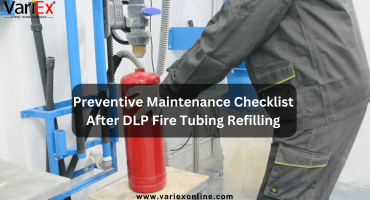 Read more +11 July 2025 in Fire Suppression
Read more +11 July 2025 in Fire Suppression

